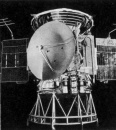May 28 1971
From The Space Library
Mars 3 probe was launched by U.S.S.R. from Baikonur at 8:26 pm local time (11:26 am EDT) into parking orbit from which it was injected into heliocentric trajectory toward Mars. Payload would supplement that of Mars 2, launched May 19. All instruments functioned normally. By 10 pm Moscow time (3 pm EDT), Mars 2 was 2 495 000 km (1 550 000 mi) from earth and Mars 3 was 44 000 km (27 000 mi), Tass reported. Each satellite weighed 4650 kg (10 250 lbs) and had as prime mission objective complex research of Mars and its atmosphere. Tass said that Mars 3 carried instrumentation for exploration of Mars and neighboring space, for investigating solar radio emission in one-meter wave band in experiment developed and manufactured by French specialists in French-Soviet cooperative program, and for measuring characteristics of solar plasma and cosmic rays. (FBIS-Sov-71-104, 6/1/71, Ll; SBD, 6/2/71, 69; Shabad, NYT, 5/29/71, 1)
U.S.S.R. launched Cosmos 424 from Plesetsk into orbit with 287-km (178.3-mi) apogee, 198-km (123-mi) perigee, 88.9-min period, and 65.3° inclination. Satellite reentered June 10. (GSFC SSR, 5/31/71; 6/30/71; SBD, 6/2/71, 169)
New mission plan had been adopted for Mariner-I (Mariner 9) Mars probe scheduled for launch no earlier than May 29, NASA announced. New plan-which would provide high-quality data return for all of original experiments but less data than planned for original two-spacecraft mission-assigned 65° inclination, 12-hr period, and 1200-km (750-mi) periapsis (low point in orbit around Mars) to Mariner-I, with Nov. 14, 1971, arrival date. New inclination would yield map covering almost 70% of Mars and period would ensure two-tape-load-per-day data return. (NASA Release 71-94)
Soviet Aviation Industry Minister Pavel Dementyev told Paris press conference Soviet supersonic transport Tu-144 was expected to go into commercial service in late 1973 or early 1974, about same time as Anglo-French Concorde. Only one Tu-144 was operational; two other prototypes under construction were expected to fly at year's end. Tu-144 had logged several hundred flying hours and flown at 2458 km per hr (1528 mph) at 6100 m (20 000 ft). Aleksey N. Tupolev, designer of Tu-144, said at press conference that Pan American World Airways President Najeeb E. Halaby was interested in aircraft, "but it is too soon to speak about markets or negotiations with international airlines until the Tu-144 has completed its test program." (Reuters, W Post, 5/29/71)
December 1970 Mariner 6 and Mariner 7 experiments to simulate uv spectrum that would be viewed by uv spectrometer observing Jupiter or other outer plants were described in Science by Univ. of Colorado scientists J. B. Pearce, K. K. Kelly, and C. A. Barth, and JPL scientist A. L. Lane. Mixture of ammonia, nitrogen, and hydrogen had been released from spacecraft 240 million km (149 million mi) from earth and 120 million km (74.5 million mi) from sun. Spectra were re-corded while gases were illuminated by sunlight. (Science, 5/28/71, 941-3)
Fourth round of Strategic Arms Limitation Talks ended in Vienna. Talks would resume in Helsinki July 8. (W Post, 5/29/71)
1 2 3 4 5 6 7 8 9 10 11 12 13 14 15 16 17 18 19 20 21 22 23 24 25 26 27 28 29 30 31

